
Volume
27, No. 8 – August 2014
Volume 27, No. 8
Editor: Stephen L. Seftenberg
Website:
www.CivilWarRoundTablePalmBeach.org
The President’s Message
Most Round Tables do not meet in the summer. It
is quite a rarity. Several years ago the Board made a decision to meet
year round. Some people were skeptical that the chairs could be
filled during the summer months. I am pleased to announce that
attendance has been excellent this yea, and exceeded expectations.
What a pleasure it is to see so many familiar faces as well as new ones.
Congratulations to the membership for supporting all our summer
programs.
Well done, troops.
Gerridine LaRovere
August 13, 2014 Program
On August 13, 2014 Janelle Bloodworth will be giving a
presentation titled: Three Civil War Human Interest Stories.
July 9, 2014 Program
Steve Seftenberg presented a program entitled: "Debunking Myths
About the Battle of Shiloh." Steve said his talk was freely based on
a 2006 article in Civil War Magazine by Timothy B. Smith, who was
then on the staff of the Shiloh National Military Park. The Battle of
Shiloh, April 6 and 7, 1862, was one of the Civil War’s most momentous
fights, but also one of the least understood. The "standard" story of
this "great and terrible" battle that cost 23,000 casualties, is that
Union troops were surprised in their camps at dawn on April 6. Defeat
seemed certain, but Union Brig. Gen. Benjamin M. Prentiss saved the day
by holding a sunken road some three feet deep (which came to be known as
the "Sunken Road") and a wooded area next to it (which came to be known
as the "Hornet’s Nest") for a crucial six hours. Prentiss eventually
capitulated, leaving Rebel commander General Albert Sidney Johnston in a
position to drive on to victory. Tragically for the Southern cause,
Johnston was then mortally wounded, blunting Confederate momentum. After
a lull of about an hour, General Pierre Gustave Toutant Beauregard
replaced him and around 6 P. M. made the fatal decision to halt further
Confederate attacks. The next day Union counterattacks dealt Rebel hopes
a crushing blow.
This "standard" account of the battle, however, is more myth than
fact. After the war Ulysses S. Grant, the Union commander, wrote that
Shiloh "has been... more persistently misunderstood than any other
engagement... during the entire rebellion." Shiloh authority and
historian David W. Reed, the first superintendent of the Shiloh National
Battlefield Park, in 1912 chimed in, writing "... occasionally...
some one thinks that his unaided memory of the events of 50 years ago is
superior to the official reports of officers... made at [the] time
of the battle. It seems hard for them to realize that oft-repeated
campfire stories, added to and enlarged, become impressed on the memory
as real facts."
Unfortunately, such misunderstandings and embellished campfire
stories have over the years become for many the "truth" about Shiloh,
painting a distorted picture of the momentous battle. Three minor
examples of this follow.
First is Johnny Clem, the supposed "Drummer Boy of Shiloh.
Clem (1851-1937) was real and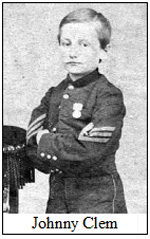 died as a major general, but never was at Shiloh. Clem’s 22nd Michigan
Infantry was not even organized until after Shiloh. His story really
belongs to the later Battle of Chickamauga but a song entitled "The
Drummer Boy of Shiloh" had already entered into the Northern public’s
psyche.
died as a major general, but never was at Shiloh. Clem’s 22nd Michigan
Infantry was not even organized until after Shiloh. His story really
belongs to the later Battle of Chickamauga but a song entitled "The
Drummer Boy of Shiloh" had already entered into the Northern public’s
psyche.
Second is the so-called "Bloody Pond," today a battlefield
landmark. There is no contemporary evidence that the pond became
bloodstained, or that in 1862 there was even a pond at the spot you can
visit today. The sole account came from a local citizen who years later
told of walking by a pond a few days after the battle and seeing it
stained with blood.
And third that thousands of hysterical Union stragglers
greeted Grant as he arrived at Pittsburg Landing. The front line Federal
divisions did not
 break
until after 9 A. M., the latest time that Grant could have arrived at
the landing. It is hard to imagine Prentiss’ troops running over two
miles in less than 30 seconds. There were some stragglers at the landing
who had skedaddled to the rear as soon as the fighting started, but they
were under control by the time Grant arrived. Of course, by 6 P. M.,
there were plenty of panicked stragglers milling around the landing
looking for an escape across the river. break
until after 9 A. M., the latest time that Grant could have arrived at
the landing. It is hard to imagine Prentiss’ troops running over two
miles in less than 30 seconds. There were some stragglers at the landing
who had skedaddled to the rear as soon as the fighting started, but they
were under control by the time Grant arrived. Of course, by 6 P. M.,
there were plenty of panicked stragglers milling around the landing
looking for an escape across the river.
Carelessness toward facts produce false history and cynical disbelief
in official records. An example Steve calls "cable TV" history: A
newspaper columnist criticized Park officials for removing the dying
tree under which Johnston supposedly died, saying, "So what if Johnston
wasn’t exactly at that exact tree."
Steve then proposed to debunk factually six persistent myths about
the Battle of Shiloh.
Myth No. 1: The Confederate attack caught the Federals totally
by surprise. Shiloh supposedly started with a surprise attack. One
author even called it "the Pearl Harbor of the Civil War." Actually,
Shiloh was not that much of a surprise even though contemporary
newspaper columns described Union soldiers being bayoneted in their
tents as they slept. One of the most widely-read accounts was by
Whitelaw Reid, of the Cincinnati Gazette, who was nowhere near
Shiloh when the Confederates attacked and based his 15,000-word story on
hearsay. The tale that Reid spread is that the Federal Army of the
Tennessee had no idea that the enemy was so near. Not so. For days
before April 6, skirmishing took place and both sides routinely took
prisoners. The Union army knew Confederates were out there -- the
problem was that neither the soldiers nor the generals knew their
strength or intentions. Two days before the battle, Sherman noted in his
report,
"On Saturday the enemy’s cavalry was again very bold, coming well
down to our front, yet I did not believe that he designed anything but a
strong demonstration." Ordered by "Old Brains," Maj. Gen. Henry W.
Halleck, not to bring on an engagement, Grant, was not about to go
looking for a fight in early April, at least not until he was reinforced
by Maj. Gen. Don Carlos Buell’s Army of the Ohio. Accordingly, Grant
sent word to his front line division commanders not to spark a fight.
Obedient to orders, Federal skirmishers and pickets continually withdrew
as the Confederates probed forward. For days, Union brigade and
regimental commanders witnessed Confederates near their camps but their
reports were ignored or dismissed. Fortunately for the Union Army, one
Union brigade commander took matters into his own hands. Without
authorization, Colonel Everett Peabody (a Harvard graduate!) sent out a
patrol before dawn on April 6 that bumped into the advance skirmishers
of the Southern force less than a mile from the Union front. The
Confederates promptly attacked, and the Battle of Shiloh was on! Because
of Peabody’s patrol, however, the Confederate attack was unmasked
earlier and began farther out from the Union camps than planned and had
to be delayed until some tardy troops could join the attack. This delay
allowed the Army of the Tennessee to mobilize. Every single Union unit
on the field met the Confederate assault south of (that is in advance
of) its camp. Peabody’s patrol prevented total tactical surprise at
Shiloh.
Myth No. 2: Prentiss was the Union "Hero of Shiloh." For
decades after the battle, Prentiss was hailed as the Federal officer who
sent out the patrol that gave early warning of the attack.
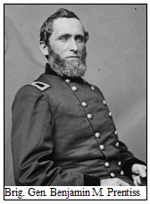 Likewise,
Prentiss was also lionized as the commander who, ordered by Grant to
hold at all hazards, defended the Hornet’s Nest for six hours against
repeated Confederate assaults. Only after the Confederates brought up
Ruggles’ 62-gun Battery and he thought he was surrounded did Prentiss
surrender "the noble and brave remnants of his division." Prentiss’
after-action report was glowing in terms of his own accomplishments.
Historians for years accepted that report at face value, one even
labeling a photo of Prentiss as the "Hero of Shiloh." The National
Military Park’s film Shiloh: Portrait of a Battle dramatically
and mistakenly paints Prentiss as the chief defender of the Union army
on April 6. Prentiss’ reputation grew until it reached iconic status. In
truth, Prentiss did not send out any patrol on the morning of April 6.
As mentioned earlier, one of his brigade commanders, Colonel Peabody,
did so in defiance of Prentiss’ orders. Prentiss rode to Peabody’s
headquarters when he heard the firing and demanded to know what Peabody
had done. When he found out, Prentiss told his subordinate he would hold
him personally responsible for bringing on a battle and rode off
in a huff. Likewise,
Prentiss was also lionized as the commander who, ordered by Grant to
hold at all hazards, defended the Hornet’s Nest for six hours against
repeated Confederate assaults. Only after the Confederates brought up
Ruggles’ 62-gun Battery and he thought he was surrounded did Prentiss
surrender "the noble and brave remnants of his division." Prentiss’
after-action report was glowing in terms of his own accomplishments.
Historians for years accepted that report at face value, one even
labeling a photo of Prentiss as the "Hero of Shiloh." The National
Military Park’s film Shiloh: Portrait of a Battle dramatically
and mistakenly paints Prentiss as the chief defender of the Union army
on April 6. Prentiss’ reputation grew until it reached iconic status. In
truth, Prentiss did not send out any patrol on the morning of April 6.
As mentioned earlier, one of his brigade commanders, Colonel Peabody,
did so in defiance of Prentiss’ orders. Prentiss rode to Peabody’s
headquarters when he heard the firing and demanded to know what Peabody
had done. When he found out, Prentiss told his subordinate he would hold
him personally responsible for bringing on a battle and rode off
in a huff.
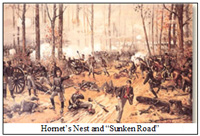 Likewise,
Prentiss was not the principal defender of the Hornet’s Nest. His
division began the day with roughly 5,400 men, only to dwindle to 500 by
9:45 that morning. By the time Prentiss took his position along a
farmer’s dirt road (more about that below), he had lost almost his
entire division, and could not have held his part of the line without
being reinforced by two Missouri brigades of Brig. Gen. W. H. L.
Wallace’s division. It was primarily Wallace’s troops, over 5,000
strong, who held the Hornet’s Nest before breaking to the landing
leaving Prentiss behind. Around 5 P. M., Prentiss surrendered about
2,000 men, of whom only 300 were from his original division. Prentiss
took full advantage of a fortuitous position as the sole surviving Union
general officer of the Hornet’s Nest. After he was exchanged 60 days
after the battle he was able to spin his story without contradiction
from Peabody and Wallace, both of whom had died from wounds received at
Shiloh. Prentiss simply took credit for their actions and became the
hero of the fight. Likewise,
Prentiss was not the principal defender of the Hornet’s Nest. His
division began the day with roughly 5,400 men, only to dwindle to 500 by
9:45 that morning. By the time Prentiss took his position along a
farmer’s dirt road (more about that below), he had lost almost his
entire division, and could not have held his part of the line without
being reinforced by two Missouri brigades of Brig. Gen. W. H. L.
Wallace’s division. It was primarily Wallace’s troops, over 5,000
strong, who held the Hornet’s Nest before breaking to the landing
leaving Prentiss behind. Around 5 P. M., Prentiss surrendered about
2,000 men, of whom only 300 were from his original division. Prentiss
took full advantage of a fortuitous position as the sole surviving Union
general officer of the Hornet’s Nest. After he was exchanged 60 days
after the battle he was able to spin his story without contradiction
from Peabody and Wallace, both of whom had died from wounds received at
Shiloh. Prentiss simply took credit for their actions and became the
hero of the fight.
Myth No. 3: Buell’s arrival near sundown on April 6 saved
Grant from defeat. Some historians argue that Grant’s beaten
army was about to be driven into the Tennessee River but was saved by
the timely arrival of Maj. Gen. Don Carlos Buell’s Army of the Ohio near
sundown on
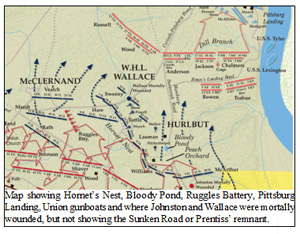 April
6, which deployed in the last Union line and repelled the final
Confederate assaults of the day. After the war, veterans of the two
Federal armies vehemently argued their contradictory cases. Even Grant
and Buell crossed swords when they wrote conflicting articles for
Century magazine in the 1880s. Buell’s article painted a picture of
a dispirited Army of the Tennessee on the brink of defeat and
destruction. Only his arrival with fresh troops saved the day. Grant
argued that his tactic of trading space for time throughout April 6 had
worked: the rebels had spent so much time breaching successive defensive
positions that daylight was fading by the time the last Confederate
assaults could began. Grant was convinced that his army could handle
them even without help. April
6, which deployed in the last Union line and repelled the final
Confederate assaults of the day. After the war, veterans of the two
Federal armies vehemently argued their contradictory cases. Even Grant
and Buell crossed swords when they wrote conflicting articles for
Century magazine in the 1880s. Buell’s article painted a picture of
a dispirited Army of the Tennessee on the brink of defeat and
destruction. Only his arrival with fresh troops saved the day. Grant
argued that his tactic of trading space for time throughout April 6 had
worked: the rebels had spent so much time breaching successive defensive
positions that daylight was fading by the time the last Confederate
assaults could began. Grant was convinced that his army could handle
them even without help.
In reality, the Confederates had little hope of breaking Grant’s
final defense line. Situated on an elevated ridge overlooking streams
known as the Dill branch, Grant’s battered forces still had enough fight
in them to hold this extremely strong position, especially since they
had over 50 artillery pieces, two Federal gunboats (shown on the map
above) and troops with good interior lines of defense. Grant’s guns
lashed the Confederates from the front, flank and rear. Around 6 P. M.,
Grant remarked to a staff officer, "not beaten yet, by a damn sight."
The fact the Confederates never actually assaulted the Federal line
in force further damages Buell’s claims. Only elements of four
disorganized and exhausted Confederate brigades crossed the Dill Branch
ravine and only two brigades undertook an assault, one of which was out
of ammunition! The few Confederates who topped the rise faced a
withering fire. Orders to withdraw did not have to be repeated. Grant
could have fended off much larger forces than he actually faced. Buell’s
arrival boosted Union morale and allowed Grant to take the offensive the
next morning, were not needed to stave off defeat that evening.
 Myth
No. 4: The South would have won had Beauregard not called off the
assaults. For many years after the battle, advocates of the "Lost
Cause" castigated Beauregard for calling off the final Confederate
assault as the sun set on April 6. The theme of the attacks was that the
Confederates had victory within their grasp and needed only one last
effort to destroy Grant’s army. Instead, Beauregard threw away a
victory. Nothing could be further from the truth. Beauregard made the
right decision to end the attacks, but for the wrong reasons. He acted
on faulty intelligence that Buell’s reinforcements were nowhere near
Pittsburg Landing. True, one of Buell’s divisions was still in Alabama,
but unfortunately for Beauregard, five were actually about to reach
Pittsburg Landing. Based on bad intelligence, Beauregard thought he
could regroup overnight and finish off Grant the next morning, before
Buell arrived. In this he was mistaken: Taking into account the terrain,
the strong Union position and Confederate tactical disarray at the time,
the Confederate chances of breaking Grant’s final line of defense, much
less destroying the Union army were nil. Beauregard did not "throw away"
a victory, but he did put himself in a position to be blamed for the
defeat already transpiring. Myth
No. 4: The South would have won had Beauregard not called off the
assaults. For many years after the battle, advocates of the "Lost
Cause" castigated Beauregard for calling off the final Confederate
assault as the sun set on April 6. The theme of the attacks was that the
Confederates had victory within their grasp and needed only one last
effort to destroy Grant’s army. Instead, Beauregard threw away a
victory. Nothing could be further from the truth. Beauregard made the
right decision to end the attacks, but for the wrong reasons. He acted
on faulty intelligence that Buell’s reinforcements were nowhere near
Pittsburg Landing. True, one of Buell’s divisions was still in Alabama,
but unfortunately for Beauregard, five were actually about to reach
Pittsburg Landing. Based on bad intelligence, Beauregard thought he
could regroup overnight and finish off Grant the next morning, before
Buell arrived. In this he was mistaken: Taking into account the terrain,
the strong Union position and Confederate tactical disarray at the time,
the Confederate chances of breaking Grant’s final line of defense, much
less destroying the Union army were nil. Beauregard did not "throw away"
a victory, but he did put himself in a position to be blamed for the
defeat already transpiring.
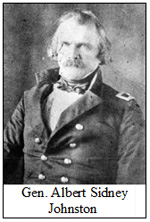 Myth
No. 5: The South would have won the battle had Johnston lived.
Another Lost Cause myth of Shiloh is that Johnston would have been
victorious had not a stray bullet clipped an artery in his leg and
caused him to bleed to death. According to legend, Johnston’s slow death
caused a lull in the battle on the critical Confederate right until a
new commander could take over, halting progress toward Pittsburg Landing
and then Beauregard then called off the attack on the Union left flank.
The result: Confederate defeat. To drive the point home, the United
Daughters of the Confederacy placed an elaborate memorial at Shiloh in
1917, with Johnston as the centerpiece and death symbolically taking the
laurel wreath of victory away from the South. Even modern scholars
sometimes follow this line of reasoning. Johnston biographer Charles
Roland argues that Johnston would have won the battle had he lived. His
superior leadership qualities, Roland concludes, would have allowed
Johnston to spur the tired Confederate troops onward to victory. Myth
No. 5: The South would have won the battle had Johnston lived.
Another Lost Cause myth of Shiloh is that Johnston would have been
victorious had not a stray bullet clipped an artery in his leg and
caused him to bleed to death. According to legend, Johnston’s slow death
caused a lull in the battle on the critical Confederate right until a
new commander could take over, halting progress toward Pittsburg Landing
and then Beauregard then called off the attack on the Union left flank.
The result: Confederate defeat. To drive the point home, the United
Daughters of the Confederacy placed an elaborate memorial at Shiloh in
1917, with Johnston as the centerpiece and death symbolically taking the
laurel wreath of victory away from the South. Even modern scholars
sometimes follow this line of reasoning. Johnston biographer Charles
Roland argues that Johnston would have won the battle had he lived. His
superior leadership qualities, Roland concludes, would have allowed
Johnston to spur the tired Confederate troops onward to victory.
Roland’s contentions fail to take the facts on the ground into
account. First, any lull in the battle was not due to Johnston slow
death. Neither side could sustain a continuous rate of fire for
logistical reasons: ordnance departments could not keep thousands of
soldiers continuously supplied with ammunition. As a result, combat at
Shiloh did not rage continuously for hours at any one time or place
(even in the Hornet’s Nest). Instead it was a complicated series of many
different actions throughout the day at many different points. There
were many lulls on the battlefield, some for as much as an hour or two.
Some historians point out that a lull occurred while Johnston expired,
but that break in action was more a result of the natural flow of the
battle than Johnston’s death. Second, the argument that Johnston
would have won even though Beauregard failed is also faulty.
Johnston could not have pressed the attack any faster than the surviving
Confederate commanders on the Confederate right could. In all
likelihood, Johnston could not have captured the Hornet’s Nest any
faster than Beauregard did. This means that Johnston would not have been
in a position to attack the ridge guarding Pittsburg Landing until after
Grant had stabilized his line of defense. The North’s concentrated
infantry, massed artillery and gunboats, Confederate exhaustion and
disorganization, unfavorable terrain and Union reinforcements were all
factors -- some more than others -- in defeating the last Confederate
attempt of the day. By 6 P. M., it is highly doubtful Shiloh could have
been a Confederate victory even with Napoleon Bonaparte in command.
 Myth
No. 6: The Sunken Road was not, in fact, sunken. Myth
No. 6: The Sunken Road was not, in fact, sunken. Visitors want
to see the Sunken Road and the Hornet’s Nest more than any other
attraction at the park. While some important fighting did take place at
the Sunken Road, the draw is predicated on the myth of deep ruts in the
road providing a natural defensive trench for the Federal soldiers. In
fact, there is no contemporary evidence that the Sunken Road was sunken
at all. What became known as the Sunken Road was a mere dirt path used
by a local farmer, Joseph Duncan, to get to various parts of his
property. Due to its limited use, the path would not have been worn
down. At most, it might develop ruts several inches deep at various
times during wet seasons. Post-battle photos of the road show a mere path, not a sunken trench. Not one single report
in the Official Records mentions the road as being sunken. Likewise, no
soldiers’ letters or diaries have been found that refer to it as sunken.
The picture of the "Sunken Road" today (at the right) is a visual
contradiction of the legend! Many buffs quote Thomas Chinn Robertson of
Gibson’s Brigade as describing the road as three feet deep. In reality,
Robertson never really saw the road. Gibson’s Brigade never reached the
site of the Sunken Road. Robertson described a tangle of undergrowth
that blocked his view. The unit shifted to the right, so Robinson never
got to see how deep farmer Duncan’s cart path actually was. In all
likelihood, he was describing the Hamburg-Savannah Road or the main
Corinth Road, both of which were heavily used and thus would have been
eroded. Federal troops occupied both roads at times during the battle.
Although the "Hornet’s Nest" label was used during the battle, the
Sunken Road label did not appear until publication of Manning Force’s
From Fort Henry to Corinth in 1881. Thereafter, veterans began
to embellish the story. The Iowa units manning the position formed a
veterans organization that emphasized the Sunken Road. When the Park was
established in 1894, the Park Commission began to highlight certain
areas, including the Sunken Road, to attract visitors. At the same time,
the proliferation of veterans’ memoirs in the 1890s and early 1900s
keyed on the growing popularity of this cart path, which grew deeper
with each passing volume, ultimately reaching a depth of three feet. As
time passed and more publications appeared, the myth became accepted as
reality. Today it is one of the best known Civil War icons that never
existed.
In Conclusion. Several factors account for the myths encrusting
the Battle of Shiloh. The park, unlike Gettysburg, was not established
until 30 years after the battle. By then, embellished memories had
become fixed. Likewise, the original Park Commission may have let pride
affect its Shiloh story. David Reed (the park’s first historian)
had fought in the 12th Iowa in the Hornet’s Nest and promoted its
importance. The Lost Cause mentality so prevalent in the postwar South
fostered antagonism against Beauregard and laments over Johnston’s death
and felt that the Confederates were outnumbered but never outfought. It
is regrettable that over the years some of the facts about the battle
have become distorted. Fortunately, however, today’s historians are
looking at the battle from a different perspective. As more research is
published, the oft-repeated campfire stories should be phased out in
favor of the grand and noble reality of Shiloh. After all, truth is
often stronger than fiction.
After a spirited question-and-answer period, Steve received
well-earned applause.
Last changed: 08/04/14
Home
About News
Newsletters
Calendar
Memories
Links Join
|

